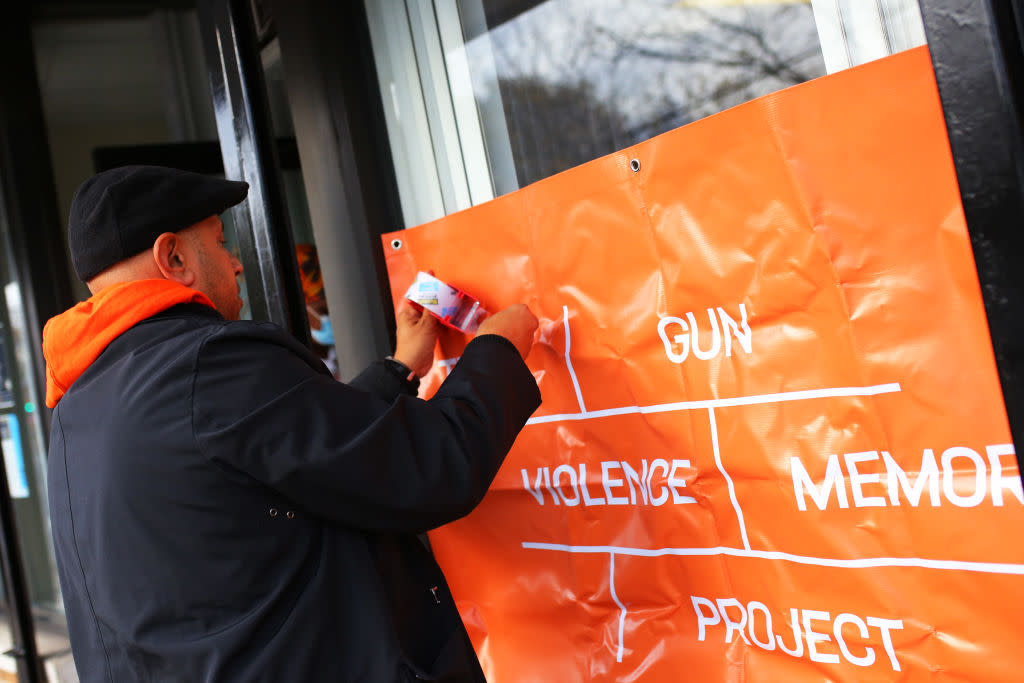The Toll Gun Violence Takes on the People Working to Stop It

Jason Rodriguez, outreach supervisor with Lifecamp, hangs a banner as families of victims of gun violence gather at Where Do We Go From Here to drop of memorabilia for the Gun Violence Memorial Project on November 11, 2021 in Queens, NYC. Credit - Michael M. Santiago—Getty Images
On June 25, Surgeon General Dr. Vivek Murthy issued a landmark Advisory on Firearm Violence, declaring the United States’ gun violence epidemic a public health crisis. Dr. Murthy detailed the devastating and far-reaching impact of firearm violence on the health and well-being of the country, noting that is now the leading cause of death Americans 19 and younger.
For gun violence prevention activists, advocates and funders, the Surgeon General’s proclamation is a sad, but important validation of a decades-long effort. It also underscores the ongoing need to support the thousands of people working on the front lines every day to reduce violence in some of our most vulnerable and under-resourced communities.
Read more: U.S. Surgeon General Declares Firearm Violence a Public Health Crisis
One of the most promising gun violence solutions, an approach called community violence intervention (CVI), relies on street outreach workers who risk their lives to save others. CVI strategies are a vital piece of the puzzle when it comes to creating safer communities: They employ evidence-informed, community-led strategies that engage individuals and groups at the highest risk of experiencing and/or perpetrating violence. This work establishes relationships and supports that disrupt cycles of violence and retaliation, and includes neighborhood-and hospital-based interventions, life coaching, peace fellowships, violence-focused cognitive behavioral therapy, and more.
The organization I lead, the Fund for a Safer Future, funds CVI work because the approach has proven to be increasingly effective. An evaluation of one program in Chicago, for example, found that participants were 73% less likely to be arrested for a violent crime than individuals who did not participate. What's more, an analysis of the Advance Peace CVI model found a 22% decrease in gun homicides and assaults, representing a cost savings of at least $25 million. And a 2021 study in Richmond, Calif. found the model was associated with a 55% reduction in firearm violence, including deaths and hospital visits, and 43 percent fewer crimes annually. These results are leading to increased investments in CVI, including $300 million allocated by Congress in 2022.
All of these CVI programs rely heavily on street outreach workers. As a former street outreach worker myself, I experienced first-hand the toll the job can take. We embed ourselves in the lives of those impacted by gun violence to mediate conflict, and in the process, we build deep relationships with them and their families. Sometimes, we still lose them to gun violence. And like other first responders, we head back out there to keep saving lives. But more often than not, it takes a toll that is invisible to most Americans.
Research by sociologist David Hureau and his collaborators from the University at Albany, partially supported by the Fund for a Safer Future, shows just how challenging community violence intervention jobs are. Based on surveys with street outreach workers in Chicago, the research is staggering: 60% of outreach workers witnessed a shooting attempt and 52% witnessed a client die from violence. One in five outreach workers had been shot at, making them 20 times more likely to be shot at than a Chicago police officer. And almost all of them face unrelenting stress: 94 % reported indicators of secondary traumatic stress—which comes from caring for traumatized people—within the previous week.
Read More: Guns Are Not Just a Public Health Problem
These statistics come to life in interviews of Chicago outreach workers conducted by University of Illinois Chicago researchers. “I think what happens is that we become so invested in the lives of other people, that we don’t realize the harms that we’re bringing upon ourselves,” said one outreach worker. “I was MIA from work for like maybe two months…I was getting very violent nightmares,” said another.
“The majority of street intervention workers have suffered tremendously,” explains Kathryn Bocanegra, an assistant professor at the school, in a 2021 study Between a Bullet and its Target: Street Intervention, Trauma Exposure and Professional Implications. “They are so brave and noble in what they are doing, going back into their community and back into the streets, and trying to redefine the narrative around what they do and who they are. But they are doing it without guns and without a bullet-proof vest.”
The implications are clear: Unless we provide health, safety, and economic security for street outreach workers, these programs will struggle to hire and retain the workers who are the key helping reduce gun violence. CVI workers deserve adequate medical and life insurance, regular screening for signs of trauma, and appropriate mental health services when they show signs of trauma.
At a meeting of CVI professionals in April, U.S. Attorney General Merrick Garland noted the significant declines in homicides across the country and thanked CVI workers for their role in creating safer communities. He also announced a new $78 million investment in CVI by the federal government. We share his gratitude and excitement for continued investment in CVI, and we will continue advocating for using these investments to support and protect street outreach workers.
For communities to fully realize the potential of CVI, we must build on that momentum and treat street outreach workers with the respect and dignity they deserve. Let’s honor the sacrifices they are making every day as they work to make our communities safer. They pour their hearts into their work and put their bodies on the line to protect ours. And they do it with determination, bravery, and love.
Contact us at letters@time.com.


